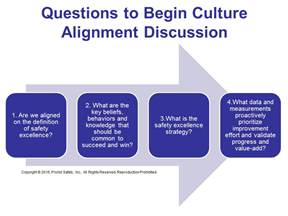Contractor Safety Management: Aligning Strategy and Culture
Far too many organizations are still focused on activities and rates.
Contractor safety management has evolved significantly, yet it still has a long way to go, specifically with aligning safety expectations, programs, cultures, and strategies between contractors and the client organizations that engage them.
Key questions have prompted this gradual evolution, beginning with "Do you do safety?" When people were hired to perform tasks or create deliverables for others, safety wasn't much of a consideration. Getting the job done and collecting the associated fee were the most important considerations. At some point, how the job was being performed became important. New expectations were created and progressive organizations begin to inquire of the contractors they employed, "How are you doing in safety?" Rates became a focal point and, for many, zero recordable injuries was the only acceptable number. This led to many positive advancements (and just as many negative practices) to meet the number.
When companies realized the limitations of managing lagging indicators, the focus evolved to, "What are you doing in safety?" Efforts were concentrated on gaining insight into what the contractor'’s safety program focused on and what tactics were deployed to continuously improve. Many organizations have become stuck here with a primary focus on rates, activities, and mandatory programs, whether they add value or not. Advanced thinking is needed to get past this. In 2015, the National Safety Council's Campbell Institute issued a whitepaper, Best Practices in Contractor Management, which supports this.
The paper outlined five major steps of a contractor lifecycle: 1. Prequalification, 2. Pre-job task and risk assessment, 3. Contractor training and orientation, 4. Monitoring of job, and 5. Post-job evaluation. The paper also highlighted a list of "best practices," some of which include third-party qualification; assessing contractor lagging-indicator safety statistics; risk-rating of work to be performed, certification, orientation and permits verification; and scheduled assessments during contract term. While this is helpful information, it highlights the reality that far too many organizations are still focused on activities and rates. Where is the overall strategy and where is the focus on aligning cultures? To this point, the paper mentions "extending the culture of safety among contract workers, especially in a global context, is another avenue of future research."
Many progressive client companies are tackling the next two steps in the evolution of safety excellence, strategy, and aligning culture based on the methodology outlined in the 2013 book, STEPS to Safety Culture ExcellenceSM. The following four questions should be utilized in client-contractor culture alignment:

1. Are we aligned on the definition of safety excellence? As basic as this might sound, this question indicates the maturity of thinking that exists between the organizations. Excellence in safety should be defined as the ability to achieve great results, knowing precisely how they were achieved, and sharing a mindset that continuous improvement and better practices will always be possible. This is a far different perspective than if an organization still defines safety by results or measurements. How aligned are the leadership teams on how safety excellence is defined, how it is obtained, how long it will take to get there, who is responsible, and what resources are necessary?
2. What are the key beliefs, behaviors, and knowledge that should be common to succeed and win? Culture is what is common within a group. It is vital that discussions occur to identify the precise beliefs and behaviors that must be common and would be when safety excellence is obtained. Also, what are the most important things someone should know about safety at the site and within the company?
3. What is the safety excellence strategy? Strategy is a framework of choices, tradeoffs, and small bets an organization makes to determine how to capture and add value. Goals to fail less often forget that the absence of failure does not equal success. Success is winning, and organizations win with internal strategies that focus on delivering value. How comprehensive is the overall safety excellence strategy between the companies?
4. What data and measurements proactively prioritize improvement effort and validate progress and value add? Data should inform strategic choices of what to continue, start, or stop in order to advance and align the culture. Moreover, measurements should not just tell you how you did, they should also provide insight into why the results were reached and motivate action to continue to improve. Don't fall into the trap of only measuring activities and results and potentially incorrectly believing activities yielded the results. Sometimes improvement occurred in spite of the chosen activities.
Both client and contractor organizations must have a strategy in place to advance safety performance and the culture that sustains it. However, if the strategies conflict, they are useless. Just as the safety strategy should support and not conflict with the business strategy, client and contractor strategies and the cultural byproduct must be aligned and should support one another. This is the next step in contractor safety management.
This article originally appeared in the February 2016 issue of Occupational Health & Safety.